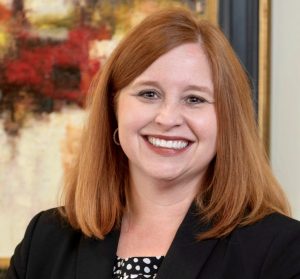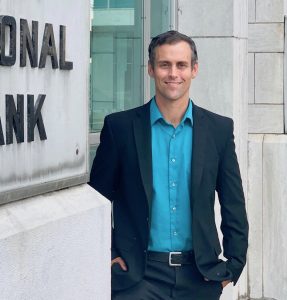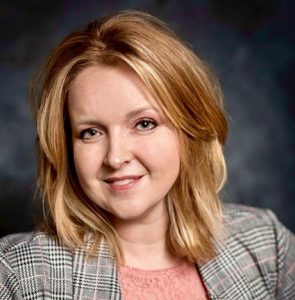State of the State 2022: To start 2022, uncertainty lingers for bank industry
by January 27, 2022 2:31 pm 1,121 views

According to Arkansas’ top bank official, the banking industry managed the past year effectively despite persistent concerns and uncertainty related to the pandemic.
“It certainly felt that way by mid-year, and I continually received comments from bankers and industry-related professionals that indicated we were largely in a more normal operating environment,” said Susannah Marshall, Arkansas State Bank Department commissioner.
But, as the pandemic lingers entering 2022, she said those same concerns are returning to the forefront for employees, customers and overall bank operations.
“Uncertainty seemed to be a good adjective for 2021, and unfortunately, that rings true today as we begin 2022,” she said.
Marshall and other Arkansas banking leaders offered various thoughts on the industry entering a new year.
According to the latest data from the Federal Deposit Insurance Corp. (FDIC), Arkansas’ 84 federally insured lenders reported a cumulative net income of $1.71 billion in the third quarter of 2021, up a whopping 71.3% from a year ago. The banks grew their combined assets to $141.5 billion, up 7.9% year-over-year. Deposits rose to $115.5 billion.

George Makris Jr. is president and CEO of Simmons First National Corp. of Pine Bluff. He said bankers have been operating in an “artificial” economy driven by the government’s injection of unprecedented stimulus payments directly to individuals and businesses. The addition of disposable income along with the supply chain issues caused by COVID-19 employment disruptions have fueled inflation at levels that, if sustained, would likely negatively impact both consumers and businesses.
“What we see in banking today is a lot of liquidity in the form of deposits, which should dwindle over time,” Makris said. “Loan volume has been anemic because of the ‘free’ cash to businesses and the reluctance to accept ‘normal’ risk in expansion plans.
“We expect to see that investment return as the market becomes driven by pure supply and demand and not by temporary government stimulus. I hope this will occur over the course of the next 12 months.”

A bank’s return on assets (ROA) is a popular metric to determine profitability. As defined by the FDIC, it shows the percentage of how profitable a company’s assets are in generating revenue. The higher the ROA, the more money the company earns on its assets. Arkansas’ collective ROA jumped from 1.07% in the third quarter of 2020 to 1.65% in the third quarter of 2021.
Makris said historic profitability will be a challenge because of the lack of loan demand and manipulated interest rates. On the flip side, demand seems to support the investment in specific geographies and industry sectors like housing.
“Asset quality is very good right now as heightened concerns resulting from the pandemic have, for the most part, failed to materialize,” Makris said. “If we can keep from starting and stopping [schools, businesses, public venues, tourism] due to COVID, we should see steady movement toward a market-driven economy.”
Makris believes the supply will eventually meet the demand when the starts and stops are controlled.
“The excess liquidity will erode, and both factors will be less influential in driving inflation,” he said. “The question is when?”

Sam Sicard, president and CEO of Fort Smith-based First Bank Corp., said the banking industry’s highly competitive nature puts pressure on all banks’ margins and profitability. However, the industry as a whole appears to be in very healthy financial condition.
“We are not expecting a downturn in the local economy nor the financial condition of the banking industry in the near future, but we do expect economic growth to moderate with the pullback of past monetary and fiscal stimulus in 2022,” he said.
Heather Albright, president of the Arkansas market for Bank of America, also expects supply chain issues to ease as the health crisis eases, which will help businesses and banks.
“When companies struggle to have inventory in place, borrowing is down because they can’t get materials,” she explained. “As we see this ease in 2022, it’ll be good for all sectors. But realistically, no one knows how the virus will evolve. However, we have learned so much and can only continue to focus on supporting our clients, communities and employees.”

The increased demand and need for additional digitization of banking products and services continue to proliferate and require bankers’ attention. Marshall said that in some ways, the trend could be characterized as a “digital race” where the winner may ultimately have a competitive advantage.
Albright said Bank of America saw record levels of digital engagement among customers during the past two years within mobile and online platforms.
“While there is a base of clients that still want to drive to their local retail location, there is an appetite for change as they see value in saving time and doing things more efficiently online,” she said.
Makris said digital adoption is Simmons’ main driver of strategic decisions. He said customers utilize the bank’s physical locations much less for transactions and more for consultative services.
“If you can make a deposit by taking a picture of a check in less than a minute, why would you make out a deposit slip, get in your car and drive at least several blocks to make the deposit,” he explained. “Same goes for bill-pay, including the obvious cost saving of a stamp every time you mail a check.
“Overall, technology will continue to allow for more efficient delivery of services internally and externally.”
He cautioned that the proliferation of fintech could be both good and bad.
“Much of that innovation is driving very good things in the financial services industry, such as more self-serve options,” he said. “However, unregulated innovation can lead to some real issues. Cryptocurrency, for instance — the currency of choice for criminals.”
Marshall also acknowledged that digital assets are becoming more common in finance-related discussions and a more mainstream activity of many bank customers.
“Innovation has always been a cornerstone of the banking industry, and I know that hallmark will continue as banks are always focused on serving their customers and meeting their financial needs,” she said.
Editor’s note: Link here to connect to the State of the State section.
